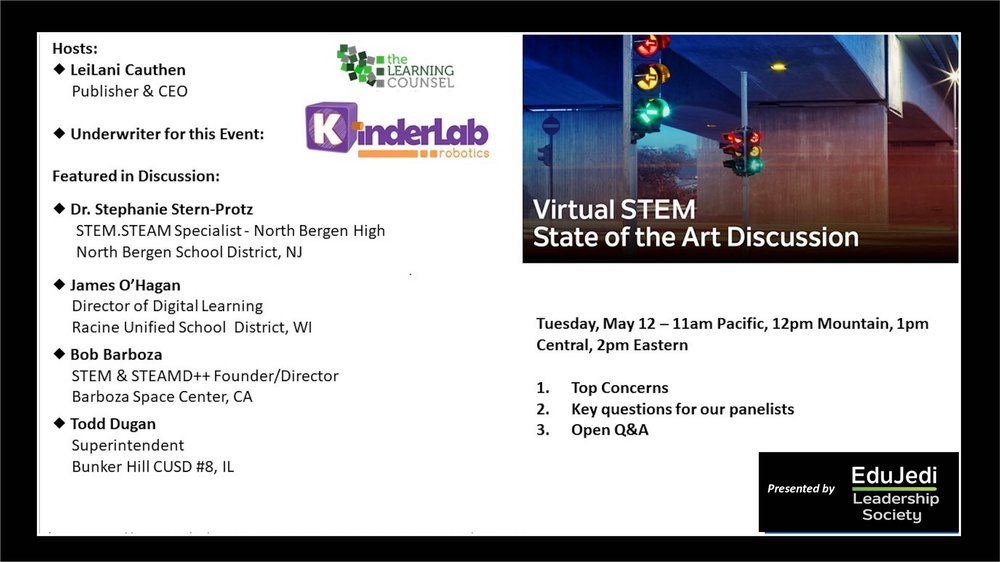Learning is at a crossroads, and the decisions we make today may well set the course for the coming years in educational instruction. In this Learning Counsel Crossroads Virtual Discussion, some of the country’s leading STEM (and STEAM) experts explain how they are working through the limitations of the COVID-19 lockdown, and how they overcame some very daunting challenges to find success for their students.
According to Marina Bers, Co-Founder and Chief Scientist at KinderLab Robotics, “We think of coding as a literacy and that means you want to understand how the world works, just like reading and writing. Think of that for a second. Reading and writing is not just so you can become a professional journalist or a novelist. Some of us will, but most of us will not. The same is true for coding. Some of us will become software engineers or programmers, but most of us will not. We want to learn how to code anyway so we can manipulate and understand what's going on around us. So, we can really think in abstract problem solving, creative ways.”
“What we're seeing now in our STEM program,” said Dr. Stephanie Stern-Protz, STEM.STEAM Specialist at North Bergen High School, “is that now we are coming into the student's life because they have to be home. We all have to be home. So how do you find that center place? You find it in the virtual space of their computer. And that has a much different effect and outcome than if they are physically walking into the building. So we can talk about flipped classrooms, but I think at this point the classroom has flipped big time and I think it's now what do we build from this transition, and what we're looking forward to, going into the summer and fall.”
James O’Hagan, Director of Digital Learning at Racine Unified School District, said “A lot of educators have gone through PD over the years to integrate technology in the classrooms. When COVID broke, they didn't quite know what to do in some cases. And I'm not saying everybody, but there was a lot of trying to figure out how do we live in navigating this world. It was a little disheartening at first, but we are getting our feet underneath us. There are great conversations that are happening around STEM education and equity of access both with technology and access to community resources.
“A lot of what we do with Esports is outside the games because we use the games as a vehicle to get us to other places. So there have been opportunities for students to develop their passions around Shoutcasting and streaming. They are developing a social media presence. They are developing their backdrops and their themes. They have been souping up their computers, they're learning how to get a little bit more juice out of something that maybe they thought was an old computer. So, there has been a great opportunity for kids to not just consume content, but this is also a time when they have a lot of freedom to create content.”
BOB Barbosa is the Founder/Director at Barboza Space Center in Long Beach, CA. Bob said, “We created a virtual notebook using a relational database so all of our kids around the world could have virtual notebooks that they could use it in their different languages that they would speak. And then we just recently discovered how wonderful that virtual notebook was when we were thrown overnight into virtual everything. So, with these virtual notebooks we are able to teach. If students do something and I need to see what's in their notebook, I can see the video, I can see the graphic, I can hear the audio. I can be a little mini-scientist because I've got this wonderful thing, we call it an astronaut’s notebook.”
According to Todd Dugan, Superintendent at Bunker Hill CUSD #8, “Some of the stuff that we have deployed during this to keep the emphasis on STEM and STEAM are Lego Education Spike Prime sets, they're about $300 each. For the price of a device, you can get a reusable, basically infinite opportunity. Parents in the rural areas seem to appreciate that much more than 12 zoom meetings. There were a lot of low-tech options for STEM.
“And as far as an entire district, how do you keep the focus on STEM and STEAM if it's not an important or priority at the district administration? We have to actually believe that STEM, STEAM and all kinds of cross curricular interdisciplinary units is the way to go for 21st century education. The importance of STEM and STEAM is not necessarily the technology piece and the science piece per se. Our district's taken the philosophy of connecting the subjects together in an integrated cross-curricular way that's true, relevant and engaging learning.”
Watch the video
Each of the panelists gave prime examples of making STEM and STEAM work in their own philosophies, using the resources they had at hand. There are some very innovative ideas here, and you’ll learn strategies to help your students now during the pandemic and beyond.











